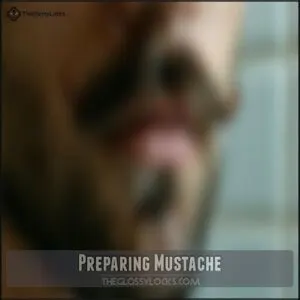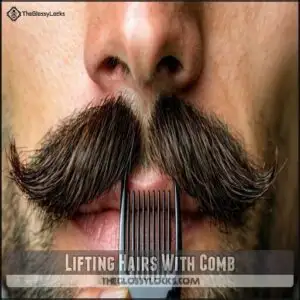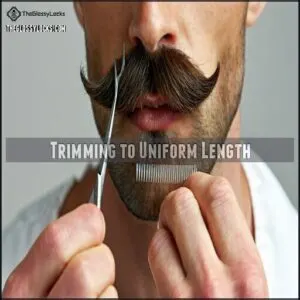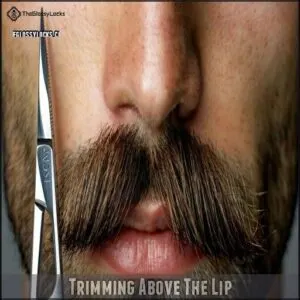This site is supported by our readers. We may earn a commission, at no cost to you, if you purchase through links.
 To trim your mustache effectively, start with a clean, dry face and comb the hairs downward.
To trim your mustache effectively, start with a clean, dry face and comb the hairs downward.
Use small, sharp scissors to trim the bottom edge just above your lip line first. For the bulk, lift sections with a comb and trim the protruding hairs to your desired length.
Work from the center outward to maintain symmetry. Clean up stray hairs with precision. Don’t rush—a steady hand separates the dapper from the disheveled.
Regular maintenance keeps your upper lip looking sharp without marathon grooming sessions. Proper tools make all the difference between a mustache that commands respect and one that collects soup.
Table Of Contents
- Key Takeaways
- Preparing Mustache
- Trimming Mustache Properly
- Choosing Mustache Style
- Trimming for Length and Shape
- Maintaining Mustache
- Frequently Asked Questions (FAQs)
- What’s the proper way to trim a mustache?
- Should I trim mustache above lip?
- How should a mustache be shaped?
- Should I trim my mustache right under my nose?
- Should your mustache be the same length as your beard?
- Should I brush my moustache down or to the side?
- What mustache style is right for me?
- How do you cut a mustache?
- How to trim your mustache for length and bushiness?
- How do you trim a stray mustache?
- Conclusion
Key Takeaways
- Start with a clean, dry face by washing thoroughly and letting your mustache completely dry before trimming, as wet hair appears longer and can lead to uneven results.
- Always comb your mustache downward before trimming to align hairs and reveal the natural shape, then use a comb to lift sections while you trim for consistent length.
- Work from the center outward when trimming above your lip line, making small, precise cuts with sharp scissors or a quality trimmer to maintain symmetry and prevent over-cutting.
- Maintain your mustache with regular trims every 3-5 days, daily application of beard oil for hydration, and consistent combing to train growth direction and distribute natural oils.
Preparing Mustache
Start by thoroughly washing your face and mustache to remove any dirt or oils that could interfere with trimming.
Dry everything completely, as trimming a damp mustache can lead to uneven results.
Washing and Drying Face
Start your mustache trim with a clean slate. Use a facial cleanser to remove oils and grime, ensuring nothing gets in the way of precision. Opt for lukewarm water—it’s gentler on your skin.
Consider using a facial hair cleanser designed for your mustache. After washing, pat your face dry with a towel instead of rubbing, which can cause tangles.
Clean, hydrated skin sets the tone for a smooth trim. Remember to use SPF 30 sunscreen for skin protection.
Let your skin and hair fully air dry before starting!
Combing Mustache
After cleaning your face, reach for a fine-toothed mustache comb—the MVP of mustache care.
Gently glide the comb through your mustache in all directions, focusing on Tangle Removal. This technique smooths out knots and also reveals your mustache’s natural contours.
Use deliberate Combing Techniques to align hairs downward, perfect for evaluating length before mustache trimming.
Regular Combing Frequency aids in Product Distribution, ensuring oils or waxes spread evenly. Treat mustache combing as your prep rally—it sets the stage for confident, precise, and successful grooming.
Ensuring Mustache is Dry
After combing your mustache, make sure it’s completely dry before trimming. Damp hair lies about its length, appearing longer than it truly is. If you trim wet, you risk over-trimming and ending up with a much shorter mustache than intended—nobody wants a surprise "mini-stache."
Here’s how to guarantee accurate length and avoid uneven results:
- Towel dry thoroughly: Pat your mustache with a clean towel until it’s moisture-free.
- Air dry for precision: Let your mustache air out naturally to restore its full texture.
- Touch test: Run your fingertips through to confirm it’s dry.
Dry hair trimming guarantees even cuts, better styling, and healthier hair.
Trimming Mustache Properly
You’re ready to tackle the main event: trimming your mustache properly. It’s all about precision, symmetry techniques, and avoiding mistakes for a polished look. The right mustache trimming tools are key—scissors offer pinpoint control, while electric trimmers guarantee consistency.
Begin at the corners of your mouth and work inward with slow, deliberate strokes. Always keep your face neutral and check progress in a well-lit mirror. Symmetry matters, so take breaks to assess your work from different angles.
For better results, use these mustache trimming tips:
- Trim small sections at a time, ensuring balance on both sides.
- Use a longer trimmer guard (4-6mm) to manage length, then adjust downwards.
- Angle slightly downward with scissors or trimmers for a natural, blended appearance.
Focus on maintaining clean lines under your nose with a precision trimmer. Your goal: sharp yet harmonious facial hair trimming. Consider using a trimmer with adjustable guide combs for versatile styling.
Choosing Mustache Style
You need to choose a mustache style that complements your face shape and personal style.
Understanding popular options like the Handlebar, Chevron, and Pencil mustaches can help you pick the right look.
Handlebar Mustache
The handlebar mustache stands out with its bold curls, requiring patience and precision to achieve.
This look begins with growth extending to the mouth’s corners. Quality mustache wax is your best ally—apply it daily to shape and hold.
Use styling techniques like upward training: sweep hairs outward, twist the ends upward, and smooth curls into place. Regular curl maintenance keeps the shape sharp.
With roots in handlebar history, this style reflects confidence and discipline—just like the attention your grooming routine demands. Ready to master unique mustache styles?
Chevron Mustache
The Chevron mustache is a bold, classic style that exudes confidence. Thick and full, it follows your natural lip line and suits square and oval face shapes perfectly.
A thick, commanding Chevron mustache frames your smile with timeless masculine confidence.
Achieve a flawless Chevron with these steps:
- Trim Dry: Always trim dry hair for accurate length assessment.
- Maintain Fullness: Focus on keeping the center full while tapering edges slightly.
- Define Edges: Trim where the mustache meets your nose, ensuring clean lines.
- Stay Consistent: Weekly maintenance trimming preserves its iconic, sharp shape.
Pencil Mustache
The pencil mustache radiates timeless charm, blending pencil thinness with sharp edges for a clean, classic look.
It’s all about defining edges along the lip line using flawless trimming techniques. Keep it narrow with consistent mustache shaping and frequent upkeep for its historical significance, admired by icons like Clark Gable.
Modern variations preserve this vintage appeal while suiting today’s styles.
Here’s a quick comparison of tools and uses:
| Tool Type | Purpose | Recommendation |
|---|---|---|
| T-Blade Trimmer | Fine lines, precise edges | Wahl Lithium Ion Pen Detailer |
| Precision Scissors | Minor adjustments | Tweezerman Mustache Scissors |
| Razor & Gel | Crisp, defined edges | Straight Razor + Transparent Gel |
Other Mustache Styles
For adventurous faces, mustache styling techniques open doors to bold, historical designs. The Walrus showcases patience with its sweeping, untamed charm. Want flair? The Imperial or English mustaches deliver elegance with upward curves. For artistic souls, try Dali’s surreal points or embrace simplicity with the Toothbrush look.
Each style has cultural significance and maintenance needs. Consider how a handlebar mustache’s elegance can transform your look.
- Standout Styles: Think Walrus or Van Dyke.
- Celebrity Inspiration: Channel Dali.
- Express Individuality with bold styles.
- Match Your Look: Experiment freely.
- Maintenance Matters: Trim and care diligently.
Trimming for Length and Shape
To achieve a balanced, polished look, focus on trimming your mustache evenly for both length and shape.
By lifting the hairs with a comb and making careful cuts, you’ll create a clean, sharp result that highlights your style.
Lifting Hairs With Comb
Once you’ve chosen your style, grab a fine-tooth mustache comb to lift hairs upward at a slight angle.
Controlling the comb angle is key; it helps define layers and reveals hidden strays. Focus on maintaining tension control, especially for thicker hair types. The right comb type guarantees a smooth process.
For those seeking a new comb, consider the available product options.
Use the table below to customize your grooming.
| Comb Feature | Purpose | Suitable For |
|---|---|---|
| Fine-tooth comb | Precision lifting | Most styles |
| Wide-tooth comb | Gentle detangling | Thick, coarse hair |
| Angled comb | Layer visualization | Handlebar styling |
| Mini pocket comb | On-the-go control | Quick touch-ups |
Trimming to Uniform Length
To achieve a polished look, trimming to a uniform length is essential. Begin with longer guard lengths (4-6mm) on your trimmer and gradually reduce until you reach your desired mustache length. Use the comb technique by holding hairs taut as you trim to maintain evenness.
For precision, mustache scissors offer better control. Snip along the outside of the comb in small, deliberate cuts. Check from various angles to catch unevenness. A variety of specialized tools exist for this purpose.
- Use quality trimming scissors.
- Trim gradually to avoid over-cutting.
- Focus on volume reduction.
- Maintain consistent trimming habits weekly.
- Rest between snips for accuracy.
Trimming Above The Lip
Trimming above the lip is all about precision and keeping your look sharp. Focus on defining the lip line while avoiding over-trimming.
Here’s a quick mustache trimming guide for this area:
- Use a small comb to lift the hairs along your natural lip line. This makes it easier to see uneven spots.
- Work from the center outward, trimming gradually. A symmetry check after each cut confirms balance.
- Hold mustache scissors at a slight angle near the lip for precision and trim carefully where the mustache meets the nose.
Following these simple mustache trimming steps will give you a clean, polished look without cutting more than you should, and help you achieve a sharp appearance.
Maintaining Mustache
You’ll need to trim your mustache every three to five days to maintain its sharp shape and prevent that unruly walrus look.
Regular application of beard oil and daily combing will keep your facial masterpiece soft, healthy, and perfectly styled between trims.
Applying Beard Oil
Your freshly trimmed mustache deserves proper hydration. Beard oil isn’t just an optional step—it’s your mustache’s best friend.
For ideal results, apply beard oil daily after showering when pores are open. Understanding mustache oil advantages can further enhance your grooming routine. Choose oils with jojoba or argan for lightweight moisture. Remember, the proper amount is just 2-3 drops—your mustache isn’t a salad needing dressing!
Regular Combing
The mustache comb is your facial hair’s best friend.
Daily combing with a quality wooden or horn comb material prevents detangling knots while training growth direction.
Hold your comb at a 45-degree angle and use short, outward strokes from center to edges—a proper comb technique distributes oils naturally.
You’ll notice immediate styling benefits as your whiskers align obediently, and this simple grooming routine takes just seconds but transforms your mustache care routine from neglected to distinguished.
This simple grooming routine is easy to follow and transforms your mustache care routine.
Trimming to Maintain Shape
Despite daily grooming, your mustache needs regular trimming to maintain its defined shape.
For consistent results:
- Trim every 3-5 days with sharp scissors or a quality trimmer
- Start with longer guard settings, gradually decreasing for precision
- Perform symmetry checks in natural lighting from multiple angles
Use a steady hand when defining edges and controlling volume. Remember—complementing your beard requires grooming precision. Take your time; you can’t glue hair back once it’s gone, which emphasizes the importance of precision.
Addressing Common Issues
Nearly every mustache enthusiast faces these common grooming mistakes.
Trimming wet hair often leads to mustache overtrimming—a hand slip that creates facial hair havoc. For uneven growth or patchy mustache problems, always check your symmetry from multiple angles.
Combat styling difficulty with precision tools and proper technique. To prevent irritation, ingrown hairs, and skin issues, clean your trimming tools regularly to eliminate bacteria buildup.
Beard acne and genetics can also affect mustache health. Remember, patience prevents most mustache disasters, and using the right techniques with proper technique is key.
Frequently Asked Questions (FAQs)
What’s the proper way to trim a mustache?
Wash and completely dry your facial hair before combing it downward.
Use scissors or an electric trimmer to cut along the lip line, working from outside to center.
Maintain symmetry by checking both sides regularly.
Should I trim mustache above lip?
Like a neat garden fence, your mustache needs trimming above the lip.
Yes, you should trim it to prevent hairs from entering your mouth while eating and to maintain a clean, polished appearance.
How should a mustache be shaped?
Comb your mustache downward, trim along the lip line working from outside to center.
Shape edges at a 45-degree angle from nostrils.
Maintain symmetry by alternating sides and finish with wax for styling.
Should I trim my mustache right under my nose?
Yes, you should trim your mustache right under your nose.
Keeping this area neat prevents hairs from tickling your nostrils and creating a messy appearance.
Use small scissors for precision and control.
Should your mustache be the same length as your beard?
Your mustache doesn’t need to match your beard length.
Many styles feature contrasting lengths for visual interest.
Consider your face shape and personal style when deciding whether to keep them uniform or different, and note that complete concepts like these can guide your decision.
Should I brush my moustache down or to the side?
Forsooth, brushing direction depends on your style goal.
Brush down first to assess length and trim evenly.
For styling, brush sideways toward the edges if you’re creating a handlebar, or downward for a natural look.
What mustache style is right for me?
Consider your face shape and personality when choosing a mustache style.
Round faces suit handlebar or horseshoe styles, while square faces work well with a chevron.
Your maintenance commitment and hair thickness also impact the right choice.
How do you cut a mustache?
Clean and dry your mustache completely, then comb it downward.
Use scissors or an electric trimmer to cut along the lip line, working from outside to center.
Finish by shaping edges and applying wax if needed.
How to trim your mustache for length and bushiness?
Worried about looking like a walrus?
Comb your dry mustache downward, use a trimmer with a guard for even length, and snip along the lip line to reduce bushiness.
Trim conservatively to avoid over-cutting.
How do you trim a stray mustache?
To trim a stray mustache hair, comb through with a fine-tooth comb, identify the culprit, then snip it with small scissors.
You’ll need good lighting and a steady hand for precision work.
Conclusion
Mastering how to trim your mustache is like conducting a delicate orchestra—every hair plays its part in the final performance.
With proper tools, regular maintenance, and patience, you’ll achieve that perfectly groomed look every time.
Remember to work systematically, maintain symmetry, and never rush the process.
Whether you’re sporting a handlebar or a pencil style, these trimming techniques will keep your facial hair looking intentional and refined.
Your mustache deserves this attention to detail.









